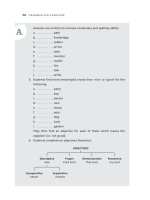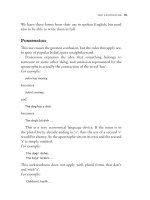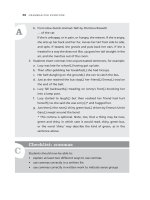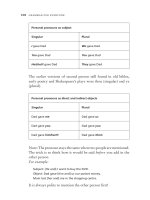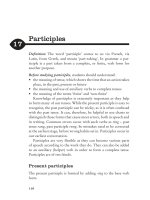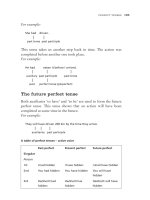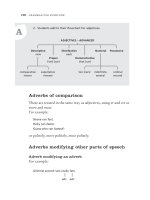Grammar for everyone part 18
Bạn đang xem bản rút gọn của tài liệu. Xem và tải ngay bản đầy đủ của tài liệu tại đây (130.07 KB, 7 trang )
acts of multiplying and dividing demonstrate a student’s under-
standing and command of number principles. The question should
not be whether you do it, but how well you do it.
In this section, we study some more terms, which are very
simple in concept and provide us with more language to talk about
language – invaluable for studying a foreign one – and skills for
the improvement of written expression.
As we think about the categories to follow, we learn much more
about how our fascinating language works. If an alien from outer
space were to land on earth and see a box for the first time, we
might try to explain that it was a container to put things in. If we
were then to actually put things into the box, the meaning would
be so much more real. In the same way, the more clearly we can
demonstrate and practise our explanations, the better they will be
understood.
We can think of verbs as the hub of every sentence. A sentence
need not include an adjective, an adverb, a preposition or an object,
but it must contain at least one finite verb.
Subjects matching verbs
The subject of a sentence must match its verb. This applies mainly
to number, but there are some pronouns that cause confusion and
warrant attention. Clear thinking enables us to avoid mistakes.
Consider the following pronouns:
Singular Plural
none (not one) both (two)
anyone several (more than two, but not many)
someone
everybody (everyone)
either/neither (one)
For example:
no one/neither has arrived
but both/all have arrived
109
M o r e A b o u t V e r b s
A
Uncountable forms are mainly in the singular.
For example:
much, little, less …
Too much rain floods (sing.) the river
Take care with the pronoun some, which can refer to an
unspecified number in the plural or an uncountable quantity.
Consider which is the case here:
Too much food is (sing.) bad for you.
There are many foods available – some are better for you than others.
Similarly, it is correct to say ‘May I have less meat’ (you cannot
count meat), but we must ask for fewer potatoes because they can
be counted.
16.1 Activities: matching pronouns
and verbs
1. Students use a selection of the above pronouns in their own
sentences and underline the verb, for example:
Neither: Neither of the boys is ready to go.
2. Students enter a verb (in the present tense) or complete the one
given.
a. No one . . . . . . . . . . toad for breakfast.
b. Both . . . . . . . . . . coming to the show.
c. Everybody . . . . . . . . . . a dog.
d. Either you or I . . . . . . . . . . misunderstood.
e. Someone . . . . . . . . . . my drink, every day.
f. Several . . . . . . . . . . at the window.
g. Neither of us . . . . . . . . . . graffiti on walls.
110
G r A M M A r f o r e V e rY o n e
C
Checklist: subject and verb agreement
Students should now be able to:
• list given pronouns under the headings Singular and Plural
• follow the given pronouns with the correct verb (orally and in
writing)
Transitive and intransitive verbs
Definition: the word ‘transitive’ is from Latin trans meaning
‘across’. A transitive verb is one that moves across to an object.
A verb that does not have (move across to) an object is therefore
in-(not)transitive.
Before studying transitive and intransitive verbs, students should
know:
• the definition and function of the object
• the difference between a direct and an indirect object
• the distinction between an object and a complement
Some verbs can be either transitive or intransitive, according to
whether or not they have an object in a given sentence.
For example:
Transitive: We bought an ice-cream.
The verb bought moves across to its object, an ice-cream.
Intransitive: I hope you don’t snore tonight.
A verb such as snore cannot take an object. You cannot snore
something!
Did you wash this morning?
There is no object, so in this sentence the verb wash is
intransitive.
but Did you wash your face this morning?
111
M o r e A b o u t V e r b s
A
Here the object is ‘your face’ so the verb wash is transitive.
Remember, the trick is to ask ‘what?’ after the verb. If you
have an answer, that answer is an object.
16.2 Activities: transitive and
intransitive verbs
1. Students take turns to give a sentence that has a transitive verb.
2. Students are given a list of verbs which they enter into two columns,
labelled Transitive and Intransitive.
a. walk
b. send
c. wonder
d. sell
e. groan
f. collide
g. dissect
h. destroy
i. peep
j. hesitate
3. Students choose verbs from those below to write two sentences for
each, one transitive and one intransitive.
a. choose
b. sing
c. draw
d. play
e. investigate
f. meet
g. paint
h. imagine
i. jump
4. Select (mark or list) the transitive verbs in the following passage.
We saw this horrible shape. It was getting closer! We dropped
our tools and ran. The shape was following us. Ben shouted, ‘I can
hear a motor.’ I heard that sound too, but I did not stop to look.
112
G r A M M A r f o r e V e rY o n e
C
A
We reached the house, grabbed the door handle and tugged the
heavy wooden door open. Just then, the dark shape covered us
and moved on. It was just the shadow of an aeroplane! We don’t
see aeroplanes here very often.
Answer:
saw, dropped, was following, hear, heard, reached,
grabbed, tugged, covered, see
5. In two minutes, students think of as many verbs as they can, that
can be both transitive and intransitive.
Checklist: transitive and intransitive
verbs
Students should now be able to:
• give the meaning of (a) a transitive verb and (b) an intransitive verb
• select and classify transitive and intransitive verbs from a sentence
or passage
• recognise verbs that can be of either kind
Active and passive voice
Like so many other features of grammar that we have been
practising, voice describes something simple that occurs in our
everyday speech. Understanding how it works and having words
with which we can talk about it enables us to manipulate our own
language or learn to use another one with greater skill.
The terms ‘active’ and ‘passive’ apply only to verbs. A verb can
be one or the other, and the verb form actually is telling us more
about its subject.
A verb in the active voice is one in which the subject performs
the action of the verb.
For example:
Jasmin kicked the ball.
Jasmin is the subject and she did the kicking.
113
M o r e A b o u t V e r b s
